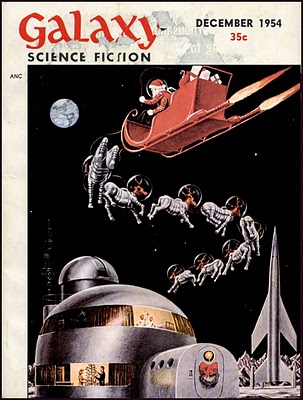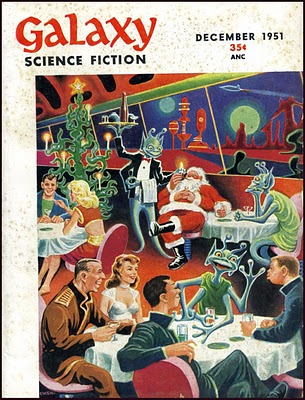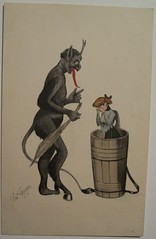
Image via Wikipedia
Christmas's winter date was probably originally chosen to co-opt the Roman festival of Saturnalia (which, according to Wikipedia, was celebrated with similar customs (gift giving, feasting) that are done to celebrate Christmas today) or pagan European celebrations of the winter solstice. The tradition of the Christmas Tree, in fact, is considered to be closely associated with pagan traditions of tree- and nature-worship; it, too, was effectively co-opted by the Christian celebration when
St Boniface (c. 672-754) [...] cut down the tree of Thor in order to disprove the legitimacy of the Norse gods to the local German tribe. St. Boniface saw a fir tree growing in the roots of the old oak. Taking this as a sign of the Christian faith, he said "...let Christ be at the center of your households..." using the fir tree as a symbol of Christianity. [3] (from Wikipedia).This is all easy enough to swallow. Christmas altogether is complex enough to be fodder for doctoral treatises, though, and perhaps one of the most interesting aspects of Christmas is the cultural phenomenon of Santa Claus, aka Saint Nicholas, aka Father Christmas. Even when you step back to consider the "basics," Santa Claus seems bizarre. He lives in the far northern reaches of the arctic, where hundreds of elves build toys for him to deliver via flying reindeer to all the Christian children of the world. But it gets even stranger than that.
Santa Claus, of course, apparently arose from pagan traditions, too - perhaps granting some credence to the complaints of those Christians who claim that he detracts from the holiday (this argument, though, falls flat in light of the pagan origins of Christmas itself). While the kindly Saint Nicholas of Myra, a Bishop from what is now part of modern Turkey, is considered to be the original Christian inspiration for the figure of Santa Claus, Father Christmas can alternatively trace his mythological origins to Germanic pagan traditions.
Says Wikipedia:
Numerous parallels have been drawn between Santa Claus and the figure of Odin, a major god amongst the Germanic peoples prior to their Christianization.[...] Odin was sometimes recorded, at the native Germanic holiday of Yule, as leading a great hunting party through the sky.[16] Two books from Iceland, the Poetic Edda, compiled in the 13th century from earlier sources, and the Prose Edda, written in the 13th century by Snorri Sturluson, describe Odin as riding an eight-legged horse named Sleipnir that could leap great distances, giving rise to comparisons to Santa Claus's reindeer.[17] Further, Odin was referred to by many names in Skaldic poetry, some of which describe his appearance or functions; these include Síðgrani,[18] Síðskeggr,[19] Langbarðr,[20] (all meaning "long beard") and Jólnir[21] ("Yule figure").Santa Claus's history takes an even weirder turn, though: excluded from modern American conceptions of Old Saint Nick is his trickster sidekick, Krampus, who is to this day an important part of the Christmas mythology in Austria and other parts of Europe. Krampus, Santa's demon-like counterpart, frightens bad children and punishes those on the naughty list by beating them with birch rods. Wikipedia notes that "images of Krampus usually show him with a basket on his back used to carry away bad children and dump them into the pits of Hell." Closely related is the similar Dutch figure Zwarte Piet (meaning "Black Peter"), the mischievous, black-faced (from chimney soot) companion of Santa Claus who kidnapped naughty children away to Spain, where Santa apparently dwells during the off-season. Both of these figures seem to stem from traditions of vanquished demons serving noble saints, their evil turned to good through the power of Christianity. While they've largely dropped their associations with the Devil, Krampus and Zwarte Piet continue to feature prominently in European Christmas celebrations. Visiting Americans often find them off-putting, but let's be honest - are they really that much weirder than our own conceptions of Santa Claus?Image by riptheskull via Flickr
Others have even suggested an association between Santa Claus and Finnish shamans' use of psychedelic mushrooms:
In Finland, the Shamans, and one in particular called Hold Nickar, are known to have worn red suits with white spots to pick the sacred Amanita Muscaria or Fly Agaric mushrooms, which are themselves red with white spots. On returning home from picking, on reindeer sleighs, they had their mushrooms in a sack, and re entered their lodges through the smoke hole in the roof ! Hold Nickar and friends ate those mushrooms to enter the Christ Consciousness, that's how he became Saint Nickar, or Saint Nicholas as we now know him !
The reindeer also ate the mushrooms, which is why they are characterized as flying, although this ties in with other older legends of gods flying the skies at night once a year giving gifts to the worthy. (read more)
At any rate, the story of Christmas is a lot more complicated than "Away in a Manger" might have you think, and not even Santa Claus is straightforward. And we won't even get in to Space Santa:


(You can see more of these at goldenagecomicbookstories.blogspot.com)


I like your post
I completely love this blog :) definitely going to need to put this on the list.
I usually don't leave comments!!! Trust me! But I liked your blog...especially this post! Would you mind terribly if I put up a backlink from my site to your site?